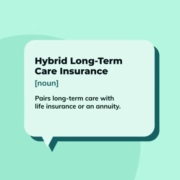Long Term Care Insurance Rate Increase – Long Term Care University

Long Term Care University – Question of the Month – 11/15/15
By Aaron Skloff, AIF, CFA, MBA
Q: We recently received a letter from our Long Term Care Insurance company notifying us that our policy premiums may increase. What options do we have?
The Problem – Long Term Care Insurance Premium Rate Increase
Almost all Traditional Long Term Care Insurance (LTCI) applications clearly state the possibility that premiums could increase in the future. The language is similar to the following, “I understand that the rates for this policy may increase in the future.” While it is expected that major medical health insurance and Medicare premiums will increase every year, Traditional LTCI premiums are designed to be level over the policyholder’s lifetime. But, with state approval the insurance company can increase the premiums. By comparison, Combination Life and Long Term Care Insurance premiums are fixed and cannot be increased by the insurance company or the state.
Click Here for Your Long Term Care Insurance Quotes

A host of factors have led to some insurance companies increasing premiums for existing policyholders, including:
- Lower than expected interest rates on the conservative bond portfolios insurance companies invest in
- Fewer than expected policy cancellations, as policyholders refuse to drop their policies
- Longer than expected claims, as policyholders file claims earlier instead of saving the benefits for future long term care
To help avoid or mitigate future rate increases, many companies have implemented:
- Higher prices for new policies with more conservative assumptions based on the three factors above
- Gender specific pricing, with higher prices for female applicants, to reflect unique morbidity and mortality risks
- Stricter underwriting guidelines to screen out riskier applicants
The Solution – Gather all the Facts so You Can Make an Informed Decision
Rather that make a quick decision without all the facts, gather all the facts and make an informed decision about your course of action. Along with your notice about the rate increase, the insurance company will provide a list of solutions. We outline those solutions below.
Cancel the Policy. Although this is often the first gut reaction, it is rarely the best solution. The whole reason you purchased LTCI is to shift the risk from you and your family to the insurance company. By cancelling your policy you shift the risk right back to yourself.
Exercise Your Contingent Nonforfeiture Feature. Most LTCI policies have a built-in feature called contingent nonforfeiture – if the company implements a large premium increase you can stop paying your policy. Even though you never have to make another premium payment, the insurance company still owns you a dollar amount of long term care equal to the cumulative premiums you have paid.
Exercise Your Nonforfeiture Feature. Most LTCI policies have an option you can purchase at the inception of the policy called nonforfeiture. With this feature you can choose to stop paying the premiums for any reason at any time and the insurance company still owns you a dollar amount of long term care equal to the cumulative premiums you have paid.
Reducing the Benefits of your Policy. Reducing the benefits of your policy can have a large impact the on premium. A reduction in benefits could actually decrease the premium. While decreasing the minimum number of years (“benefit multiplier”) on a policy from six years to five years will reduce the benefits by almost 17%, the premium decrease will be closer to 6%. While decreasing the maximum daily benefit from $300 per day to $200 per day will reduce the daily benefit by almost 33%, it will also decrease the premium by almost 33%. One of the biggest changes a policyholder can make is reducing the inflation protection rate.
Recently, one of the largest LTCI companies notified its policyholders of a rate increase. Policyholders with 5% inflation protection had the choice to accept a 24% rate increase. Or, policyholders could reduce their inflation protection rate to 3% and experience an almost 13% rate decrease. While no policyholder wants to reduce their benefits, sometimes it is the best solution.
Action Step – Gather all the Facts so You Can Make an Informed Decision
When faced with a rate increase, put your emotions aside, gather all the facts and make an informed decision.
Aaron Skloff, Accredited Investment Fiduciary (AIF), Chartered Financial Analyst (CFA) charter holder, Master of Business Administration (MBA), is the Chief Executive Officer of Skloff Financial Group, a Registered Investment Advisory firm. The firm specializes in financial planning and investment management services for high net worth individuals and benefits for small to middle sized companies. He can be contacted at www.skloff.com or 908-464-3060.












